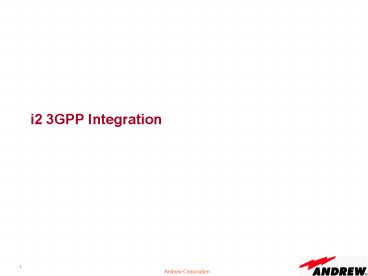i2 3GPP Integration - PowerPoint PPT Presentation
1 / 9
Title:
i2 3GPP Integration
Description:
Andrew Corporation ... Andrew Corporation. Scenario 2 IMS CSCF used from non-3GPP access. UE. Goals ... Andrew Corporation. Items for consideration ... – PowerPoint PPT presentation
Number of Views:41
Avg rating:3.0/5.0
Title: i2 3GPP Integration
1
i2 3GPP Integration
2
3GPP emergency architecture and signaling
Ref. 3GPP 23.167 v7.3.0
3
i2 Network architecture
Ref. NENA 08-001 Issue 1
4
Scenarios under consideration
Scenario 1 A generic IP device user on a 3GPP
access network (any arbitrary IP-CAN) utilizing
an Internet-based VoIP service which is outside
the scope of the 3GPP operator network. A generic
IP device may expect to use a common location
acquisition protocol to a LIS as described in the
NENA i2 architecture or a 3GPP-specific LCS
function in the access network for subsequent
conveyance of location information in the
Internet-based VoIP service protocol. Where
mid-call location updates are required, the 3GPP
IMS network may be expected to support location
requests to a LIS function from the VPC used by
the VoIP provider and as described in the NENA i2
architecture. Scenario 2 A 3GPP IMS VoIP
subscriber accessing the VoIP service from a
non-3GPP access network (ICAN). Location obtained
from a LIS in that access network will be
provided in the form of a presence information
data format location object (PIDF-LO) or in the
form of a location reference. The IMS client and
server software will need to operate with
location information provided in that form. Where
location is provided by reference, the LRF in the
IMS network will need to use the location
retrieval protocol supported by the access
network LIS thereby acting as a VPC as described
in the NENA i2 architecture. Where mid-call
location updates are required from the emergency
authority, the LIS will further expect such
requests from the 3GPP IMS core network as if it
were a VPC function
REF LS (S2-063485) on RE Joint ESIF/NENA
Liaison to 3GPP SA2
5
Scenario 1 UE on 3GPP access using Internet
VoIP service working to i2 architecture
VSP
ESGW
To PSAP via ISUP/SR
V4
V2
V1
VPC
UE
V-e2
GMLC
SMLC
SAS
SLP
Goals- VPC can get location for initial
routing - VPC can route mid-call location update
requests to access network
6
Scenario 1 Adding LIS front end to LRF
VSP
ESGW
To PSAP via ISUP/SR
V4
V2
V1
VPC
UE
V3
LIS
V0
V-e2
Le
GMLC
SMLC
SAS
SLP
Effects- LIS presents i2 standard interfaces to
terminal and to VPC - LIS leverages existing LRF
capability for location determination - Location
reference provided by LIS de-referenced by VPC
for initial and updated locations
7
Scenario 2 IMS CSCF used from non-3GPP access
LIS
UE
Goals- LRF can get location for initial
routing - LRF can obtain mid-call location update
8
Scenario 2 LRF uses LIS
LIS
V0
UE
V3
Effects- LIS provided location used by LRF for
initial routing - LRF uses V3 interface to LIS to
obtain mid-call location update based location
reference
9
Items for consideration
- Location by reference provides the most
flexibility in terms of ensuring mid-call updates
can be supported - For scenario 2, can LIS provided location
reference pass transparently through IMS CSCF and
on to LRF - For scenario 2, there is no local P-CSCF. Need
mechanism to have UE use S/E-CSCF by default - For scenario 2, the area of coverage of the 3rd
party, non-3GPP, access may be outside CSCF PSAP
catchment - Contingency to have CSCF route into i2 service
domain e.g. via V6 interface































